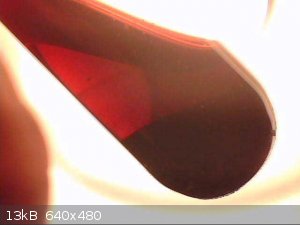| Pages:
1
2 |
Toady
Harmless

Posts: 15
Registered: 16-10-2016
Location: Beyond the pale
Member Is Offline
Mood: PISSED
|
|
Just thought I would point out, that in sufficient concentrations, when hot, concentrated phosphoric acid (>80-85% if memory serves, for this is
from reading, I've never of course attempted to damage my own glassware with it) will etch and corrode glass.
Hyperbolic, hypergolic, viral and chiral,
My laevo is on the right side.
|
|
|
wg48
National Hazard
   
Posts: 821
Registered: 21-11-2015
Member Is Offline
Mood: No Mood
|
|
Here is a pic of the ruby red Mn solution made from the calcined battery gunk and 32% sulphuric acid as per my last post. The colour is so intense it
looks black except when viewed with a bright light behind the 10mm test tube as seen in the pic.
The intensity does not appear to be decreasing. Its now 7 days old, if this is Mn(III) it does not appear to be decomposing or disproportioning
anymore than the original solution has.

|
|
|
fusso
International Hazard
    
Posts: 1922
Registered: 23-6-2017
Location: 4 ∥ universes ahead of you
Member Is Offline
|
|
I had also tried made some red Mn soln ~2yrs ago. I used alkaline batteries as the MnxOy in Zn/C ones are impure and contained probably some Fe. I
first reacted the MnxOy in oxalic acid. the oxalic soln turned red gradually and this had surprised me since I expected the soln should had either
turned pink or a white to pink MnC2O4 to ppt out. Therefore I suspect Mn3+ had formed since it's purple red in soln. I then added H2SO4 to the soln
and filtered to remove any insolble stuff but the red didnt fade. At that time, I wasnt very concious about stoichiometry so I used way more excess of
H2SO4 (I forgot how much oxalic I used). The soln stayed red for a few weeks and I wasnt sure why. I finally destroyed the red soln by turning it
pink. However since it was done a long time ago, I forgot what reagent I used to destroy the redsoln. But I still kept the Mn2+ soln so I can use in
the future.
|
|
|
| Pages:
1
2 |